Luxman C-1000 Is a Sybarite's Shining Light
The Equipment: Luxman C-1000 Prestige Control Center, a stereo-preamp /control center in rosewood veneer case.
Dimensions: 19 by 6 inches (front panel, excluding 1-inch legs); 9 5 / 8 inches deep, plus clearance for controls and connections. Price: $895. Warranty: three years parts and la bor. Manufacturer: Lux Audio, Japan; U.S. distributor: Lux Audio of America, Ltd., 200 Aerial Way, Syosset, N.Y. 11791.
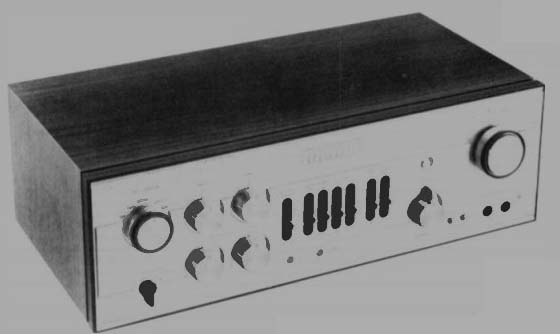
Comment: If a pretty face were all that it takes to succeed in the world of audio, one would dub the Luxman C-1000 a winner without a second thought. It is really difficult to do the front panel justice in a verbal description, for, although the number of controls it presents exceeds the usual plethora by a good margin, the arrangement and spacing are such that the eye receives an over-all impression of serene harmony. The fact that the controls actually feel good as well adds to the sensuous luxury of the design.
At the upper left of the front panel is a large selector knob, silky-smooth in its operation, that can be switched among AUX 1, TUNER, PHONO 1, PHONO 2, and Aux 2. Below the selector is a switch labeled LINEAR EQUALIZER and equipped with a pointer that can be moved from a neutral center position to any of four others, two marked UP TILT and two DOWN TILT. To the right of the selector are the BASS and TREBLE knobs, each having 21 detented positions. A three-position switch below each of these tone controls sets turnover frequency-150, 300, or 600 Hz for the bass, 1.5, 3, or 6 kHz for the treble.
Further to the right, at the center of the panel, is a bank of seven three-position levers. The leftmost of these by passes the tone controls when in the center position and can switch in a LOW BOOST function in addition to the tone controls. The next introduces a LOW CUT filter with a choice of cutoffs: 70 Hz with 12 dB per octave rolloff, or 10 Hz with 18 dB per octave rolloff. The third switch controls a HIGH CUT filter in a similar way, with cutoffs at 7 and 12 kHz, both rolling off at 12 dB per octave. The next two switches are grouped together under the label MODE. The leftmost of the pair can be moved from its normal position to cut out either stereo channel; the other can choose STEREO, REVERSE (an exchange of channels), or MONO. The rightmost pair of levers controls the input/Output functions of two tape decks to allow monitoring from either while recording is in progress or to allow dubbing in either direction, even while the user listens to a different source.
Further to the right is a pilot light, and below that is a dual control. The "tab" element is a balance control de tented at its center position; the main knob, a secondary volume control labeled ATTENUATOR, is used to fill in the "holes" in the detented primary one-the large, distinctively detailed knob that dominates the right end of the panel. Three on/off pushbuttons are located below this large knob: one for the unit itself, each of the others for a pair of loudspeakers. Above the main volume control is a panel lamp labeled TOUCH MUTE, about which more will be said later. Two screwdriver adjustments-elegant ones- toward the bottom center of the panel adjust the load impedance of PHONO 1 between 30,000 and 100,000 ohms and allow the sensitivity of both phono inputs to be varied by ±5 dB. A stereo headphone jack at the bottom right completes the front panel.
While the back panel is less distinguished in appearance than the front. it is by no means unattractive. At the left is a stack of AC convenience outlets, two switched and two unswitched, each rated at 300 watts maximum. Just to the right of this are a power-line fuse and the power cord, followed by an array of spring-loaded terminals (they accept stripped wires) that make the output connections for two stereo pairs of loudspeakers. An additional set of similar terminals further to the right is for connections to the out put of the power amplifier. (This arrangement allows the control center to switch the loudspeakers and, incidentally, provides power for the headphone jack.) Continuing rightward we find two rows of stereo pin-jack pairs. First there are two sets of outputs (allowing two power amps to be driven). Then there are monitor inputs and record outputs for each of two tape decks. (These are duplicated immediately below as DIN jacks.) The remain der are for the tuner, aux, and phono inputs. Separate in put level controls are provided for TUNER and AUX 1. Finally, there is a thumbscrew that accepts ground leads.
The approach to tone controls taken by the designers of the Luxman C-1000 is unusual to say the very least. In addition to the defeatable tone controls with their variable turnover frequencies, there is the LINEAR EQUALIZER. When switched to the first up-tilt position it rotates the frequency-response curve about an "axis" at about 1 kHz, so that the level at 10 kHz is + 1 dB and that at 100 Hz is -1 dB with the curve left almost (but not quite) a straight line.
The second up-tilt position increases the deviation to + 2 dB and -2 dB, respectively, while the corresponding down tilt positions reverse matters, depressing the treble and raising the bass. Frankly, we found the effect barely audible. More obvious is the action of the Low BOOST, which can be brought into play along with the tone controls. This increases the response at 70 Hz and below, reaching + 8 dB at 15 Hz.
Another interesting feature is the touch mute system associated with the main volume control, which is divided into two concentric regions that do not, however, rotate separately. A firm touch on the inner region causes the sound level to drop by 16 dB and the touch mute indicator to light. A touch on the outer portion restores the original level; consequently, whenever you adjust the volume-control knob it will disable the touch mute.
Clicks and thumps at turn-on are prevented by a circuit that keeps the output stage shut down for several seconds until things stabilize. During this time the pilot light winks reassuringly to show that there is no malfunction.
The performance of the C-1000 is virtually impeccable. Clipping occurs at 13 volts. The data from the CBS Technology Center show that, at a more reasonable 2 volts, THD is less than 0.0064% for all conditions, and inter modulation distortion is 0.002% or less. The frequency-response curve can be drawn with a straightedge from 10 Hz to 20 kHz and falls off to only -2 dB at 100 kHz. Noise is 76 dB down at the phono inputs and at least 84 dB down at the high-level inputs. With sensitivity at maximum, 3.0 millivolts at a phono input produces 2 volts' output; the corresponding figure for the other inputs is 300 millivolts.
About the only thing we can find fault with is the occasionally sluggish response of the touch mute on one sample we tried.
Fine instrument that it is, the Luxman C-1000 is not for everyone, in personality as well as price. It is quite conservative in styling and overall design philosophy. No con cessions are made to quadriphonics, present or future, al though the PHONO 1 input, curiously, could accommodate a CD-4 cartridge. The unit is designed more for complete convenience than for elaborate signal processing-in short, it is more a Rolls-Royce than a Ferrari. But if you are a sybaritic audiophile with a budget to match. the C-1000 will pamper you as few preamps can.
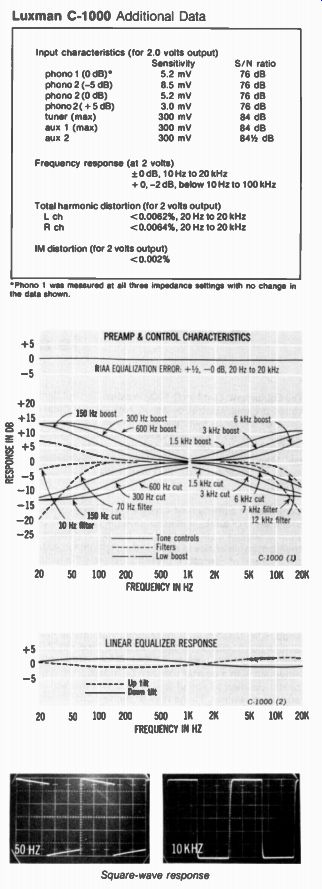
Luxman C-1000 -- Additional Data
Input characteristics
phono 1(0 dB), phono 2 (-5 dB), phono 2 (0 dB), phono 2( + 5 dB) tuner (max), aux 1 (max), aux 2 (for 2.0 volts output)
Sensitivity 5.2 mV 8.5 mV 5.2 mV 3.0 mV 300 mV 300 mV 300 mV S/N ratio 76 dB 76 dB 76 dB 76 dB 84 dB 84 dB 84 1/2 dB
Frequency response (at 2 volts) 0 dB,10Hz to 20kHz +0, -2dB, below 10Hz to100kHz
Total harmonic distortion (for 2 volts output)
L ch <0.0062%, 20 Hz to 20 kHz
R ch <0.0064%, 20 Hz to 20 kHz
IM distortion (for 2 volts output) <0.002%
Phono 1 was measured at all three impedance settings with no change in the data shown.
CONTROL CHARACTERISTICS
++++++++
A New Phase (Response) in B&O Speakers
The Equipment: Beovox M-70 Uni-Phase loudspeaker system, with matching stand.
Dimensions: 25 3/4 by 12 3/4 inches (front panel) by 10 inches deep; height on stand: 39 1/2 inches; diameter of base: 15 inches.
Price: $700 per pair.
Warranty: one year parts and labor.
Manufacturer: Bang & Olufsen, Denmark; U.S. distributor: Bang & Olufsen of America, 2271 Devon Ave., Elk Grove Village, Ill. 60007.
Comment: Over the years the sources of coloration in loud speakers have proved to be more elusive than originally thought. Two units with virtually identical frequency response and distortion would time after time-to the consternation of their designers--sound perceptibly different.
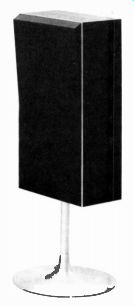
(The old saw that, if two loudspeakers sound different, one or both must be wrong, has more than a small grain of truth.) More recently, designers have begun to consider phase distortion (frequency-dependent delays that separate signal components that originate together in time, creating a "smear" that cannot happen naturally) as a source of coloration. The M-70 is, then, the top member of a line of loudspeakers in which B&O has sought to sup press phase distortion.
A single look at the front panel of the Uni-Phase speakers--including the M-70, whose upper and lower halves meet in a flat V-suggests that they are unusual. The angled panel allows the position of the unit to be adjusted so that the distances from the individual drivers to the ear are approximately equal-one aid to phase coherence. The dark rosewood veneer cabinet and black grille cloth with bright metal trim add up to a handsome appearance to which the brushed metal stand contributes as well.
The back panel has small sockets that fit onto studs so you can hang the speaker on the stand. Lower down is a screw receptacle that accepts a threaded rod, which can be turned by means of a knurled thumbscrew to adjust the vertical firing angle of the loudspeaker. There are no operating controls. Input connections are made (unfortunately, for the U.S. market at least) by means of a male DIN plug housed in a recess on the lower right quadrant of the back panel. Supplied with each unit is a two-conductor cable-the 4-meter (13-foot) length is standard; a 10-meter (33-foot) length can be purchased--with molded DIN connections at both ends. Few amplifiers available in the U.S. have DIN output jacks (though of course B&O's electronics do). We solved the problem by cutting off the cable's amplifier-end plug and stripping the wires-hardly a complex operation. Neither is phasing, since the leads are coded.
Model M-70 is sold in stereo pairs, with closely matched veneer and symmetrically placed nameplates. They're relatively heavy for their size; the carton with two units inside weighs over 100 pounds.
In its internal construction the speaker is a three-way system (woofer, midrange, and tweeter) with a difference.
The difference is a fourth driver that is active around the woofer-to-midrange crossover frequency (500 Hz) and that, in conjunction with a specially designed network, acts to correct the anomalous phase behavior associated with crossovers. This crossover-correcting, or "filler," driver is a hallmark of the Uni-Phase line.
Lab tests made at CBS Technology Center show a fairly wide range and reasonably low distortion. The omnidirectional response in the anechoic chamber is within ± 5 dB (for a reference level of 80 dB) from 43 Hz to 11 kHz.
Efficiency of the M-70 is quite low: 16.3 watts were needed to produce the 94-dB test level (200 to 6,000 Hz at 1 meter). At 300 Hz the speaker begins distorting excessively by the time output has reached 105 dB (for an input of 100 watts) but continues to handle pulses without excessive distortion to the limit of the test amplifier at 300 watts (average-600 watts, peak) for an output of over 112 dB. These figures indicate good dynamic range and power handling ability. Impedance, rated at 4 to 8 ohms by B&O, tests out at above 6 ohms (the measured rating point) throughout the audio range and above 8 ohms only in the bass-resonance region-an unusually flat impedance curve, suggesting excellent power-transfer characteristics.
On test tones we found that the bass holds up well to about 38 Hz, where, despite the still-strong fundamental, the third harmonic becomes appreciable. White noise is re produced clearly, with just a hint of coloration in the mid bass. Dispersion is good, with a 15-kHz tone audible to nearly 45 degrees off axis; for some reason white noise shows more apparent beaming in our listening room though its high-frequency components still hold up well to about 30 degrees off axis.
We found the Beovox M-70 a most pleasant speaker to hear-with rock, jazz, or classics. In particular, spoken voices (which, due to our familiarity with their natural sound, represent a severe test) are reproduced without the nasal "honk" coloring each transient that appears in so many speakers. In fact the only real clue that this is a loudspeaker (as opposed to a live speaker) is a gentle "chiff" on sibilants, infinitely preferable to honks. Some tendency toward high-frequency ringing is evident in oscilloscope photos of tone bursts, which may account for the chiff; we were unable to find aural evidence of ringing in listening to music. And musical transient response is superb-clear and precise, without the brittleness that this so often implies. We found that we could listen comfortably at levels that usually seem distressingly loud, a further index of clean highs.
If you want to partake of these pleasures and are feeling frail, we recommend that you get help in installation.
Hefting the carton is no easy matter. And when you come to the setup be advised (as B&O has advised us but for bears to mention in its instructions) that you should put the speakers face down on the floor and attach the stands to them, rather than mount the speakers on the stands in the normal position. If you take the latter (and, to us, more obvious) approach, you're bound to have trouble.
When the job is done, however, you'll have a truly excellent speaker with, we believe, few peers in its price class.
The sound is clear and accurate, rather than spectacular.
This may not appeal to everyone at first, but the more one listens, the fonder of it one becomes. The suppression of phase distortion does, indeed, seem to contribute to this quality. If a loudspeaker is a window on the world of sound, E3&0 has made it significantly harder to tell whether the glass is really there.

----------
Beovox M-70 Uni-Phase Harmonic Distortion --- Distortion data are taken on all tested speakers until distortion exceeds the 10% level or the speaker produces the spurious output known as buzzing, whichever occurs first.
+++++++++++++++++++++
Clean Looks, Clean Sound in a New Pioneer Tuner
The Equipment: Pioneer TX-9500, a stereo FM/AM tuner in metal case.
Dimensions: 16 1/2 by 5 1/2 inches (front panel) by 12 1/4 inches deep, plus clearance for controls and connections.
Price: $400. Warranty: two years parts and labor.
Manufacturer: Pioneer Electronic Corp., Japan; U.S. distributor: U.S. Pioneer Electronics Corp., 75 Oxford Dr., Moonachie, N.J. 07074.
Comment: This new tuner, the TX-9500, is the successor to the TX-9100 (HF test reports, December 1973). It is quite different, however, both in concept and appearance.
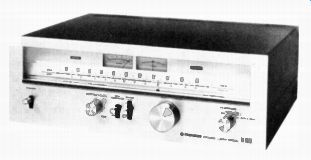
The new face sports a clean look that is very well carried off-not too stark, gently reposeful, and yet eye-catching.
A tuning dial with 8 1/2 inches separating 88 and 108 MHz appropriately dominates the front panel. A signal-strength meter (left) and center-channel meter nestle together just above the dial, flanked by windows labeled POWER and STEREO that are back-lighted when their respective announcements are in order. Below the dial are three knobs and three levers that control most functions.
A two-position lever for POWER on/off is at the left. A knob that adjusts audio output level and a lever for MPX
NOISE FILTER on/off are grouped together with a three-position MUTING LEVEL switch (muting at 22 microvolts' input, 5 microvolts' input, or not at all) toward bottom center of the panel. Just a bit further to the right is a large tuning knob, followed by a FUNCTION switch that can choose AM, FM AUTO, FM MONO, or REC LEVEL CHECK-an interesting feature that we will describe in more detail later.
A look behind the scenes reveals a two-position slide switch for FM DE-EMPHASIS (75 microseconds for normal use or 25 microseconds for use with a Dolby decoder) located at the upper left corner of the back panel and held in the 75-microsecond position by a screw-secured retainer.
Almost directly below this are four thumbscrew binding posts: two for an AM antenna and ground, two for a 300 ohm FM antenna connection. There also is a clamp-and screw terminal for a 75-ohm FM antenna.
Continuing to the right, one finds the usual ferrite-rod AM antenna followed by three pairs of pin jacks. The first pair provides horizontal and vertical outputs for an oscilloscope (to be used for multipath detection and as an aid to tuning), with the horizontal jack carrying the additional legend 4-cH MPX OUTPUT (obviously for use if a quadriphonic broadcast standard is approved by the FCC). The next pair constitutes a fixed-level stereo output, and the final pair is variable in level, controlled by the knob on the front panel. The AC-power cord and a convenience outlet (unswitched, 200 watts maximum) occupy the lower right corner of the back panel.
In general, the TX-9500 is as convenient to operate as i is attractive. The switches and knobs are all smooth and yet positive in their operation. Dial calibration is not quite perfect but is certainly close enough so that after one has zeroed in via the center-channel meter there is no doubt about what station one has tuned. The REC LEVEL CHECK feature causes a 440-Hz tone to be generated internally and passed on to the output, appearing at the fixed-level jacks at, nominally, the level of 50% FM modulation standard Dolby reference level. It can be used to adjust a Dolby decoder or to preset levels when you are recording off air. If you can receive Dolby broadcasts and have a de coder with no provision for de-emphasis switching, you may find the Pioneer's own de-emphasis switch distinctly out of the way--unless, of course, you want to listen only to the Dolby broadcasts.
In listening, we found the TX-9500 to be a fine per former. Lab tests made at the CBS Technology Center sup port this conclusion-uncovering, at the same time, some specifications that should make one or two super-tuners take notice. Midband sensitivity for 30 dB of quieting is 1.6 microvolts. More important, 50 dB of quieting is achieved in mono with an input of only 2.5 microvolts. In stereo (where the action of the FM AUTO circuit ensures at least 35 dB of quieting or else switches to mono) the ultimate quieting is 46 dB (10 dB less than that in mono). The limiting factor appears to be distortion (0.75% or less, even at 10 kHz), which is far less obvious than noise. Ultimate signal to-noise ratio is a sterling 81 dB. The other measurements (see "Additional Data") lie well within the superior range and match well enough that no one compromises the over all performance.
The Pioneer, to our way of thinking, just misses being a super-tuner. (So, in its way, does its price.) This tuner equals or exceeds its predecessor in just about all areas except for distortion in the stereo mode. Although lacking a few features of the TX-9100 (that would be rarely used in most installations), the TX-9500 does what it should and does it well. The unit remains unobtrusive until called upon, responding then competently and with no unpleasant surprises.
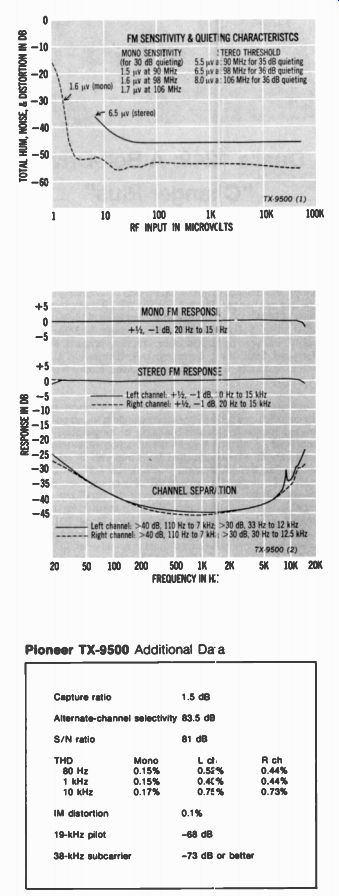
--------- Pioneer TX-9500 Additional Data
+++++++++++++++++++++++
Dual's 1249: A Belt-Drive "Changer Plus"
The Equipment: Dual Model 1249, a two-speed (33 and 45) automatic multiple-play turntable with integral arm.
Dimensions: 14 3/4 by 12 inches (top plate; approximately 1 inch additional clearance required in both dimensions for counterbalance); clearance of approximately 2 1/4 inches below and 5 1/4 inches above top surface of mounting board for use as changer.
Price: $279.95; WB-19 walnut-veneer base, $16.95; LB-19 simulated-walnut base, $15.95; DC-9 dust cover, $15.95; DC-6 low-profile cover, $13.95. Warranty: one year parts and labor, shipping prepaid.
Manufacturer: Dual, West Germany; U.S. distributor: United Audio Products, 120 S. Columbus Ave., Mount Vernon, N.Y. 10553.
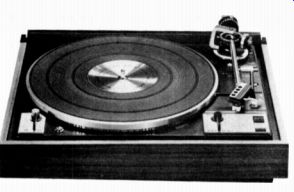
Comment: The 1249 might be called a "changer plus," since it includes automatic features seldom found on auto mated turntables, record-changing or single-play. It is, moreover, a further step in the direction of automatics that cannot be distinguished from manuals in terms of performance measurements. In one respect-rumble-it betters (though by a mere 1/2 dB) any changer we've yet measured and comes within 1 or 2 dB of all the most rumble-free single-play units CBS has measured for us: all, that is, except Dual's own record-holding Model 701.
Power for the turntable is provided by a synchronous motor (with no measurable change in speed when CBS varied AC power between 105 and 127 volts) and a belt drive.
The platter (which weighed in at the lab at 2 3/4 pounds) has an ingenious cast-in strobe scale that can be used with either 50- or 60-Hz illumination. The speed lever at the left front has a knurled fine-tuning knob at its fulcrum; adjustment is made by setting the lever to 33 and rotating the knob until the markings, illuminated by a small strobe light at the right front of the platter, appear to stand still.
Once the platter is set for 33 rpm it is engineered to be correct at 45; there are no strobe markings for the higher speed. The control range at 33 measures -4.4 to + 3.6%; at 45 it is -0.9 to + 2.0%. The start/stop lever is to the right of the platter. It can be used for automatic multi-play operation or automatic single-play. For semiautomatic operation you simply re lease the latch on the arm support, raise the arm (which starts the motor), and place it in position to play the record-using the damped cueing control to the right of the arm support (which functions nicely with no side drift) if you wish. Arm return is automatic at the end of the record side. The lab measured tripping force at 0.3 gram, slightly higher than the 0.25 gram minimum VTF at which Dual says the unit can be operated. This is a moot point, however, since VTFs desirable with today's cartridges- even the most compliant-are closer to 1 gram.
For multiplay operation--which yields a 13-second change cycle at 33 rpm--you use the changer spindle, of course (a stub that rotates with the platter plus an adapter for large-hole 45s also are provided) and turn a lever at the base of the arm mount from SINGLE to mu m. This not only engages the changer function, but raises the arm mount by about 1/4 inch, making the arm parallel to the record surface in playing, roughly, the third record in the stack. The changer operation is designed for a maximum stack of six records. Some users, particularly if they seldom stack more than two records at a time, may wish that arm height and changer operation had not been coupled so that vertical tracking angle could remain optimized for one record even in the multiplay mode. To our mind this would be perfectionism run rampant since the "errors" involved are minute and in any event far smaller than the departures from the 15-degree "standard" in cartridge styli.
One unusual automation feature is a little mechanical switch near the cueing lever and marked 1/ 09 . The 1 position is normal; the CC' (which stands for infinity, of course) indicates that in this position the unit will play the record until you direct otherwise.
There is nothing difficult about setting up the turntable.
We are always annoyed by the black/white coding on the signal leads of European turntables when so much of the remaining audio world-including pickup-connection leads-is on the red-for-right standard. But Dual, unlike some of its competitors, does give correct instructions in its manual, and one need look them up only once if the 1249 is to remain permanently in the same system. And black-and-white pin plugs certainly will please most American buyers far more than DIN-only fittings.
Dual has retained the clip-in cartridge mount (as op posed to a fully removable head shell) and the molded plastic stylus height-and-overhang gauge of previous models. Arm balance is achieved by adjusting the position of the counterweight at the back of the arm; then the VTF is set at a dial near the arm pivot. Antiskating is dialed-accurately, with respect to theoretically desirable values-on a triple-scale (for spherical, elliptical, and CD-4 styli) control next to the arm-lift adjustment.
The "shell" and pivot designs are cosmetically some what different from previous models but functionally similar-the full gimbal bearings (in which the lab could measure no appreciable friction) have been retained, for example. As the accompanying table shows, the VTF set tings are accurate to within 0.1 gram almost to the top of its range, with a maximum (and negligible) inaccuracy of 0.2 gram at the 3-gram setting. Arm resonance (with the Shure V-15 Type III cartridge) shows a rise of only 1 1/2 dB at 9.5 Hz-which suggests minimum problems in tracking even severely warped records. The rumble measurement, alluded to before, is -63 1/2 dB by the CBS-ARLL method.
ANSI/IEEE peak wow is very low at 0.05% average and 0.08% maximum. In use, the unit behaves faultlessly.
In short, Dual is keeping up with recent improvements in single-play turntables by once again producing a changer that will outperform many manuals and approach even the best. This is, on all counts, a superb changer and a fine turntable by any standard.

Dual 1249
Additional Data
Stylus-force gauge accuracy (grams)
Setting | Measured
0.5 1.0 1.5 2.0 2.5 3.0 0.5
0.95 1.4 1.9 2.4 2.8
++++++++++++++
Sansui SC-3000 Cassette Deck: Handsome and Highly Capable
The Equipment: Sansui Model SC-3000, a front-loading Dolby stereo cassette deck in metal case. Dimensions: 17.25 by 6 1/4 inches (front panel) by 11 1/2 inches deep plus clearance for controls and connections. Price: approx. $360. Warranty: one year parts, six months labor (exclusive of heads and cosmetic features). Manufacturer: Sansui Electric Co., Ltd., Japan; U.S. distributor: Sansui Electronics Corp., 55-11 Queens Blvd., Woodside, N.Y. 11377.
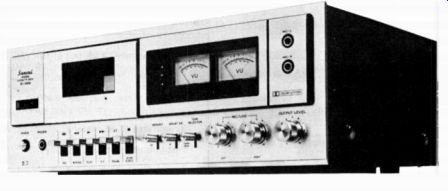
Comment: As regular readers of these reports know, we have not been very enthusiastic about the rush to front loading cassette-deck designs since some have tended to be materially more complex or more awkward to use than conventional top-load designs. The SC-3000's well is very much like that of a top-loader; the cassette within it is al most as visible as and the mechanism not much more complex than those of top-loaders, scotching most of the reservations we've had. The styling is fresh and functional and the operation eminently sane. It is, in a word, an at tractive product.
To the left of the cassette well is a three-digit counter. To its right are the meters, which are of the averaging type, flanked on the right by phone-jack mike inputs and on the left by three light-emitting diodes: RECORD, DOLBY NR, and PEAK. The first two diodes are simply pilot lights for the indicated function switching; the PEAK LED is designed to light when instantaneous signal levels exceed 6 dB above the meters' indicated 0 VU (which is calibrated at 2 dB be low the Dolby-level indication). Thus the averaging meters are designed to read 0 VU at about 4 dB below the DIN 0 VU, while the peak indicator triggers at about 2 dB above DIN 0 VU. These values seem well chosen, as long as the user takes care to allow as little triggering of the LED as possible, since its threshold level is very near the actual midrange overload point of most tapes. Since the meters are only moderately large and their needle action quite quick (the needles "flicker" more than those of professional meters on music with a strong beat) they are not particularly easy to read. We found ourselves using the meters as a rough indication of level and relying almost entirely on the LED for precise setting of the level controls.
There are three level controls at the bottom right of the front panel. One is for output level; the other two are MIC/ LINE controls for each channel. Each controls the line level in one channel until you plug a mike into its input jack, which disconnects the line feed in favor of the mike signal.
You cannot mix inputs, though you can record a mono mike signal in one channel and a mono line signal in the other. Nor can you make one-hand fades in both channels simultaneously without considerable dexterity and practice. (Had Sansui used one knob for level in both channels and the other for interchannel balance fades would have been easier to manage.) Next to the knobs are three levers: MEMORY, Dolby NR, and TAPE SELECTOR. The first controls a memory-rewind feature to stop the tape when the counter reaches 000. It and the Dolby switches have on/off positions, while the tape switch is marked NORMAL (LH) to-chromium. The NORMAL position, Sansui has given us to understand, is adjusted to match TDK D (Dynamic) and similar tapes, and we tested it with D. Both on the bench and in the listening room the match is excellent. But Sansui, like a number of other manufacturers (and this is a subject on which we've commented when we've encountered i: in the past), sup plies a fairly long list of tapes and recommended switch positions. It should be obvious to the user that not all of these tapes can match the deck with equal success. When we tried Maxell LN, for example, we could hear a slight loss in highs; when we switched to Maxell UD or UD-XL (tapes that, because of their price, the uninitiated might suppose would provide better performance than the modestly priced LN), there was audible emphasis given to the high end. In both cases, of course, use of the Dolby noise reduction exaggerates these nonlinearities slightly. Even so, the differences are so small that they should go unnoticed by all but the really critical listener. But be warned that, if the signals you plan to record already contain audible hiss, the premium ferric tapes may be slightly less satisfactory (be cause they emphasize the hiss) than the budget types (be cause they suppress the hiss as they roll off the highs) with the SC-3000 and Dolby.
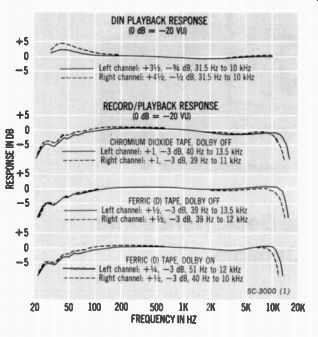
------- DIN PLAYBACK RESPONSE (0 dB = -20 VU)
Similarly, the Sansui table shows TD SA (Super Avilyn) as usable with the CHROMIUM switch position. We found this to work well with Dolby off (TDK' i recommendation, incidentally, where the deck can't be readjusted for Dolby level with SA's output, which is higher than that of chromes), but the dulling of highs with the Dolby circuit on is audible enough that few users would we think, find SA's premium price justified with this combination. Any chrome tapes we tried proved a good match to the CHROMIUM position with Dolby on. With the TAPE switch set to NORMAL and Dolby on, we found a good match wit n TDK D, Memorex MRX,, and Fuji FL. The transport controls are solid-feeling rectangular levers below the cassette well. (All the controls have excellent "feel," in fact.) You can switch from any motion function to any other without pressing STOP in between. The STOP lever itself also doubles as the EJ ECT lever; pressing it will not eject the cassette when the tape is in motion, how ever-only stop it. A second press is required once the tape is stopped, so that the user can't inadvertently (and annoyingly) eject the cassette during stop-and-go use. This design, which is not uncommon, seems particularly convenient to us. The transport shuts itself off automatically at the end of the tape in any mode.
At the bottom left of the front panel are a stereo head phone jack (whose output level is controlled by the same knob as the line output, of course) and an on /off pushbutton for AC power. On the back panel are pin-jack pairs for line input and line output connections, a DIN input/output connector, and a binding post for a separate ground lead should one be required.
The heart of the drive system is an electronically con trolled DC motor. Tests at CBS Technology Center show that even with the line AC lowered to 105 volts the speed accuracy of our sample stays just within Sansui's 2% spec; at higher line voltages the accuracy improves somewhat.
(As voltage goes up, speed goes down. This is not surprising, for we have found similar data on other electronically controlled DC-drive products in the past. The explanation is to be found in the response of the control circuit--rather than the motor--to the altered line voltage.) The capstan is mechanically decoupled from the hub-drive system, which may account for the excellent (0.08%, measured by the ANSI/IEEE standard in record/play) wow-and-flutter figure.
Both mechanically and electronically the unit meets Sansui's specs at every point where our bench testing can confirm them. Noise is low, channel separation extremely high, erasure excellent. As mentioned earlier, the record/ play response with TDK D tape is extremely flat; with TDK chrome the response is not quite as flat but still is very fine.
In terms of operating convenience and reproduced sound the deck strikes us as excellent. Even head cleaning (which requires removal of the cassette-well door) is al most as easy with this front-loading design as it is with most top-loaders and easier than it is with some top loaders and many front-loaders. (Sansui) supplies a head cleaning accessory with the unit.)
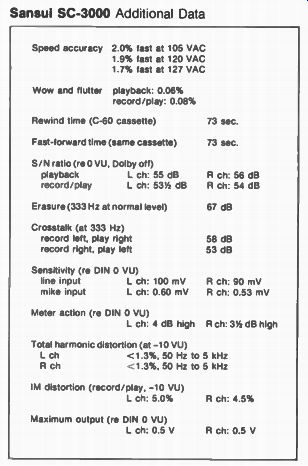
-------- Sansui SC-3000: Additional Data
The features and controls are well thought-out, though there are two fairly obvious omissions: mike/line mixing and Dolby-FM decode/recording switching. It is our impression that relatively few home users actually need the mixing feature, which does add to cost, so Sansui's decision to omit it would appear sensible. The extra Dolby switching presumably would add a little to cost too, but there currently are enough Dolby broadcasters in this country that the feature would appear to be useful. Either feature can be added via outboard equipment of course, though the cost is much higher than that of the built-in equivalents. But these are questions that each designer--and purchaser--must answer for himself. And the basic design decisions--those affecting sound quality--have been very well handled indeed by Sansui.
------
(High Fidelity, Feb. 1976)
Also see:
The Best Tape Recordings You'll Ever Make--Robert Long and Edward J. Foster; How-to with graphic aids